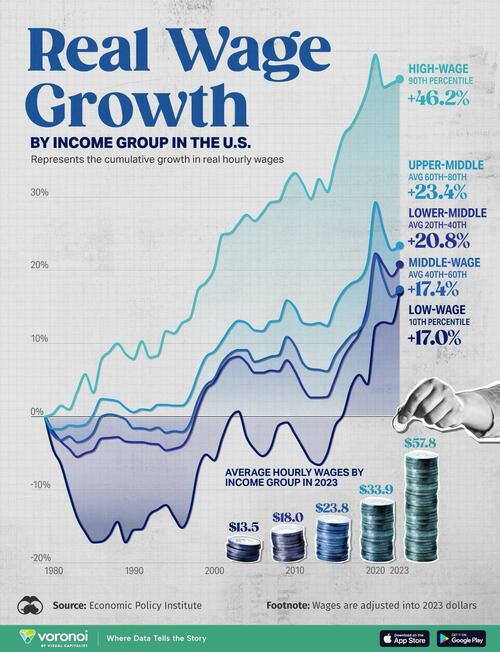Since 1979, the top income earners in America have seen their real wages grow at more than double the rate of every other income group.
Given this rapid rise, income inequality in the U.S. exceeds nearly every other rich nation, driven by several complex factors. Among these, tax policy, technological change, and economic downturns have widened this gap. Diminishing bargaining power across workers has also contributed to wage disparities.
This graphic, via Visual Capitalist's Dorothy Neufeld, shows the growth in real wages over time across income groups, based on data from the Economic Policy Institute.
Stark Differences in Real Wages Over Time
Below, we show the cumulative growth in real wages between 1979 and 2023 by wage group:
As we can see, the lowest paid workers in America have seen their real wages increase just 17% over the period—averaging a dismal 0.4% annual growth rate.
If we take out the pandemic-era’s period of strong wage growth for low-wage workers, this figure drops to 0.1% between 1979 and 2019. By contrast, real wages boomed at an annualized rate of 2.9% over the pandemic, outpacing wage growth in the previous 40 years combined.
A similar trend of slow wage growth can be seen across all other income groups apart from the highest income earners. This has contributed to the middle-class—those falling between the lowest and highest income quintiles—to shrink from 61% of the population in 1971 to 51% in 2023.
At the same time, the share of lower-income households grew by 27% in 1971 to 30% in 2023, while the share of upper-income households rose from 11% to 19% over the period.
Wage Growth During the Pandemic
As we can see in the table below, high labor demand during the pandemic led to significant wage increases, particularly for lower-income groups:
What is notable about these wage gains is that they outpaced inflation, which totaled nearly 20% over this period.
Today, a strong labor market is continuing to push real wages above inflation as price pressures have eased, but this growth has slowed considerably since pandemic peaks. In June 2024, year-over-year real wage growth was 0.8% on average, compared to 7.7% in April 2020.


